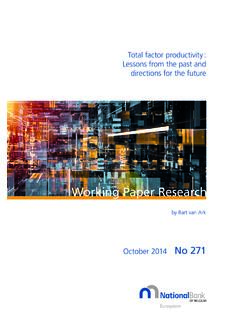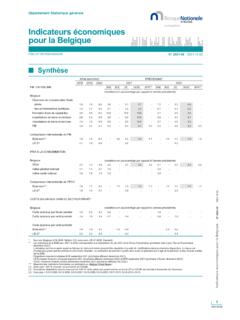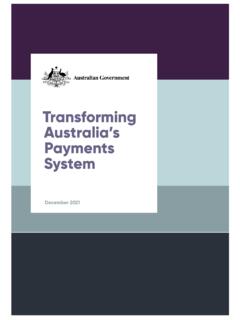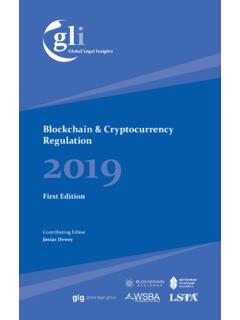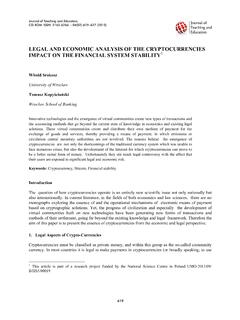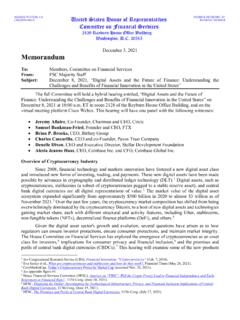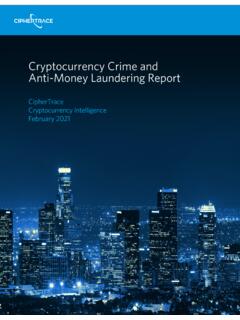Transcription of FINTECH 2021
1 FINTECH . 2021. The impact of FINTECH and digitisation on the Belgian banking sector Contents I. Introduction & approach 2. II. Sectoral trends 3. a. Scenarios relating to FINTECH development 3. b. SWOT analysis 5. c. Banks top risks related to FINTECH and digitisation are cyber risk and strategic & profitability risks 6. III. Analysis of the digitisation of the Belgian banks 7. a. Methodology 7. b. Results of this analysis 8. c. Analysis of the new business models and technologies of banks 9. IV. Conclusions : observations & best practices 15. I. Introduction & approach Digitisation is today more than ever a key driver of success for banks. Considering the acceleration of the digitisation of society linked to the COVID-19 pandemic, the technological advances as well as the competitive context marked by the entry into the banking and financial sector of challengers and (big)tech actors, banks need a strong digital strategy to ensure their sustainability.
2 Given the importance of digitisation for the banking sector as well as its rapid development, the National Bank of Belgium ( the NBB or the Bank ) decided in 2020 to launch a new FINTECH and digitisation survey. This new survey follows up on the NBB's 2017 survey which had enabled the Bank to identify digitisation-related trends and issues, to steer its supervisory action proactively as well as to communicate best practices to the sector. The aims of this new survey were fourfold : First, to update the NBB's knowledge of the digitisation of the Belgian banking sector and take stock of the evolutions and potential threats since the 2017 survey. Therefore, the banks were asked their views regarding the general impact of FINTECH on the banking sector, the existing competition with FINTECH and bigtech actors, their competitive position within the Belgian and European markets as well as the threats, opportunities and risks linked to digitisation.
3 Second, the questionnaire aimed to provide a 360 -degree view on how digitisation is handled by banks and to assess to which extent the 2017 NBB recommendations were implemented, as well as to identify potential pitfalls. To this end, banks received detailed questions regarding digitisation within their organisation, strategy, and experience, in particular in key areas such as, for example, payments or mobile and internet banking. Third, the NBB wished to further ready itself for the arrival of new technologies and business models within the Belgian banking sector. The NBB collected information on the potential of business models and technologies such as crowdfunding, peer-to-peer lending, credit scoring using AI / ML, etc., and bank's initiatives linked thereto. Moreover, the banks were queried on their assessment of the maturity of certain underlying technologies such as blockchain, AI/.
4 Machine learning, APIs, etc., and their initiatives relating these new technologies and techniques. Finally, the NBB also wanted to collect feedbacks of the banks on the regulatory framework and its supervisory practices regarding FINTECH and digitisation. In this report, the NBB aims to provide the public with a general overview of the results of this FINTECH survey by analysing sectoral trends (Section II), the digitisation of Belgian banks (Section III), and finally, by communicating its observations and best practices regarding FINTECH and digitisation (Section IV). FINTECH 2021 The impact of FINTECH and digitisation on the Belgian banking sector 2. II. Sectoral trends a. Scenarios relating to FINTECH development The evolution of FINTECH and digitisation in the Belgian banking sector is here analysed based on the five scenarios of the Basel committee regarding the impact of FINTECH on banks considering which actor manages the customer relationship, and which actor ultimately provides the services and takes the risk.
5 These scenarios can be summarised as follows : Scenario Service provider Customer (product and risk interface management). Incumbents revamp legacy with a modern Better bank digital client interface New banks build for digital and an enhanced New bank digital customer experience Incumbents Digital interface Distributed bank FINTECH Digital interface Bigtech Digital interface Customers Incumbents Aggregators of nancial services Relegated bank FINTECH built by ntech/bigtech Bigtech FINTECH providing full service eg DLT, Disintermediated bank Bigtech providing full service eg DLT, Incumbent banks New players Specialised ntech companies Bigtech companies Source : BCBS, Sound Practices : implications of FINTECH developments for banks and bank supervisors (2018). TheColour better bank code: red isindicates the most optimistic incumbent scenario banks ; purplefor current new playersplayer ; grey as according specialised to this ntech scenario, companies incumbent ; and blue banks willbigtech adaptcompanies.
6 To digitisation and retain customer relationship. Source : BCBS illustration of scenarios based on the ankNXT study The future of banking: Thefour new bank scenario scenarios, is October 2015, optimistic for incumbent banks as it foresees that they will not be able to survive the wave of technology and be replaced by new technology driven bank. Example of such trends can be found in neo challenger bank such as N26 in Germany, Orange Bank in France or Revolut. FINTECH 2021 The impact of FINTECH and digitisation on the Belgian banking sector 3. In the distributed bank scenario, services are provided by incumbents or other players who plug and play on an interface which might be owned by any player in the market. This is a scenario where fintechs and banks act as a joint venture as for example is already the case in the payment area with Apple pay and Android Pay.
7 In the fourth scenario, banks are relegated to the back office and lose the customer relationship to other firms. In the disintermediated bank scenario, banks have become irrelevant as customers interact directly with individual service providers as would be the case where FINTECH provide full services without the need for a bank, for example within value transfer networks where payments could be made without bank intervening. Certain so-called Decentralised Finance or DeFi applications are an illustration of this scenario. The Belgian sector's perception regarding the materialisation of the Basel Committee scenarios has not fundamentally changed since 2017 ; earlier views have further consolidated and extreme scenarios are considered less probable. The materialisation differs depending on the market segment at stake. For example, the distributed bank scenario is much more present in the payment area where the arrival of significant new players ( Apple Pay, etc.)
8 Is observed while the better bank scenario can be observed in domains where banks focus on improving digital user experience. 2017 2020. Disintermediated Disintermediated 6% 56 % 38 % 6% 39 % 56 %. bank bank Relegated bank 19 % 63 % 19 % Relegated bank 17 % 72 % 11 %. New bank 6% 75 % 19 % New bank 11 % 56 % 33 %. Distributed bank 44 % 44 % 13 % Distributed bank 50 % 33 % 17 %. Better bank 63 % 38 % 0% Better bank 78 % 22 % 0 %. 0% 20 % 40 % 60 % 80 % 100 % 0% 20 % 40 % 60 % 80 % 100 %. Highly probable Possible Highly improbable Source : NBB analysis based on the replies to the structured FINTECH questionnaire. FINTECH 2021 The impact of FINTECH and digitisation on the Belgian banking sector 4. b. SWOT analysis The strengths ( S ), weaknesses ( W ), opportunities ( O ) and threats ( T ) in relation to digitisation for the Belgian banking sector are mostly aligned with those observed in 2017.
9 However, new elements (highlighted in blue) were observed in the context of the 2020 survey which are linked to the emergence of the open and beyond banking model where banks are opening their systems, concluding new partnerships, and offering new services, sometimes beyond their traditional banking services. While such banking model offer opportunities, they also entail weaknesses linked to the conclusion of partnerships. Indeed, finding the right partner and establishing a valid revenue scheme with a partner can prove challenging. Moreover, such partnerships can lead to (high) dependence on a third party. Next to such weakness, the entry into the sector of bigtech is perceived as a threat by the sector given the competitive advantage of such players which enjoy large financial resources, credibility as well as IT and data capabilities.
10 Hence, banks consider disintermediation as a threat considering such competition, a threat which might be enhanced by the deployment of stablecoins and central bank digital currencies (CBDC) 1 in the future. Finally, banks fear they will have difficulties in finding digital talents. Large, established clients base & deep Legacy IT & digitalisation knowledge on customers Lack of in-house skills Financial resources and innovation capacity (for bigger banks) Difficulties linked to partnerships : dependance on third party, non clarity Experience with regulation (authorisation of revenue model of partnership as credit institution, risk management, AML & KYC) For smaller bank : budget constraints and bargaining power Trusted by clients S W. Increased quality of products and services O T Loss of physical contact and customer relationship disintermediation Optimisation of internal processes Bigtechs competitive advantages Increased insight in customer behavior and Strategic / business model risk preferences Battle for talents Open (cooperation) and beyond banking (offer of new services) CBDC / stablecoins 1.
